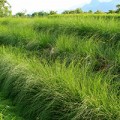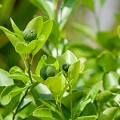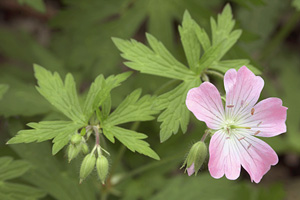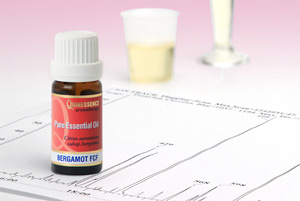Complete Guide to Geranium Essential Oil
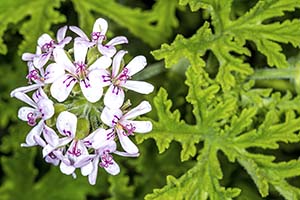 People are often surprised to learn that geranium essential oil is not obtained from the type of ‘geranium’ plants found growing in their gardens.
People are often surprised to learn that geranium essential oil is not obtained from the type of ‘geranium’ plants found growing in their gardens.
It actually comes from various plants belonging to the Pelargonium family, and there are several different ones used to produce essential oil.
This mix up was caused back in 1737 by the father of modern botanical nomenclature, Carolus Linnaeus, when he combined all the Geranium, Pelargonium and Erodium genera together into one big happy family. Many years later the genera were separated and re-categorised, but by then the damage was done!
The common term of ‘geranium’ had become so well established that despite many attempts since the 1800’s to adopt the new taxonomic name, the old horticultural term has persisted. To this day, many horticulturists still refer to the different species of Pelargonium as ‘geraniums’, as can be seen when buying plants at nurseries.
General Description
Pelargonium graveolens is a non-hardy, perennial shrub, with an upright bushy habit that reaches a height of up to 1 metre . It has an extensive root system and copious grey-green stems that darken and harden with age. The dark green leaves are variable dependant on climate and soil conditions, but are typically 7 cm in length, deeply lobed, pointed and highly fragrant. Fragrant essential oil is located in glandular hairs on the leaves. The small, pale pink/rose coloured flowers are grouped together in dense clusters, and are also fragrant.
The first Pelargonium recorded in history was in 1672 when the German botanist, Paul Hermann, collected a sample of P. cucullatum he discovered growing on the Table Mountain of South Africa. Various plant collectors, ships surgeons and naturalists who sailed the trade routes around the Cape of Good Hope brought Pelargoniums back from their voyages in the early 17th century. In fact, about 200 of the 250 known species of Pelargonium are native to South Africa, but due to massive hybridisation after their introduction to Europe at this time many species today bear little resemblance to their original parentage.
During the 18th century, hundreds of these European hybrids were returned to South Africa, and were later introduced to Australia, Comoros, El Salvador, France, India, Israel, Madagascar, Morocco, Reunion Island, Russia, Spain and North America, all of which produced geranium oil. Much later in the 1940’s Pelargoniums were introduced to the Yunnan province of China, and Egypt.
China is now the largest producer of geranium oil, with perhaps Egypt the second most important producer, followed by Morocco, Africa and Reunion. Egyptian geranium oil is considered by experts to be of a better quality than the Chinese oil, whilst geranium Bourbon (Reunion) is considered superior to all others.
Traditional uses
Pelargonium plants have been used throughout history to treat a wide range of conditions, but due to the confusion with ‘geranium’ plants, accurately documented ethnobotanical citations are not at all common. The references in many early aromatherapy books actually relate to the British plant Herb Robert (Geranium robertianum) and the American Cranesbill (Geranium maculatum) and not P. graveolens. Unfortunately, this information has been recycled in newer books ever since which keeps the confusion circulating.
In African bush medicine, Pelargoniums were believed to be astringent, antifungal, anti-inflammatory, antiseptic and styptic. The medicine men in Sotho and Zulu tribes created a paste from crushed leaves to staunch bleeding, treat wounds and abscesses, and used the roots in an infusion to wash patients suffering from fever.
Used externally, Pelargonium leaves were used to treat neuralgia, throat infections and a wide range of skin conditions such as ringworm, ulcers and rashes. It was taken internally for diarrhoea, dysentery, colic, gastroenteritis, haemorrhage, menstrual problems, kidney and bladder disorders.
Harvesting and extraction
As the flowers reach full bloom the essential oil content of the leaves increases, so this is the time to harvest the plants providing the weather is dry. Small producers usually cut the herb by hand to avoid collecting the stalks which don’t contain any oil because mechanical cutters are unable to collect leaves alone, so the stalks must be separated by hand after gathering. After cutting, the herbage is sometimes allowed to wilt in a clean shaded area to increase the yield of essential oil.
To obtain geranium essential oil the leaves and stalks are steam distilled, and the resulting essential oil has a sweet, leafy rosy fragrance with faintly fruity and minty overtones. The colour of the geranium oil varies according to its cultivar and country of origin, but broadly speaking the oil from China and Reunion is a pale olive-green colour, whilst Egyptian and Moroccan geranium essential oil is a pale yellow colour.
Geranium essential oil benefits
If you had to sum up the therapeutic properties of geranium oil in one word, it would be ‘balancing’. It is possibly the finest oil for this beneficial action, and the list of applications for geranium oil on both body and mind are almost endless. Wherever you need to bring balance, think of this oil since it is probably the most important geranium essential oil benefits. It is an absolutely indispensable essential oil.
However, it is also an effective antibacterial agent too. A study published in the Iranian Journal of Microbiology tested geranium essential oil’s effect on a variety of bacteria. The bacteria tested were Listeria monocytogenes, Salmonella enteritidis, Pseudomonas aeruginosa, Escherichia coli, Staphylococcus aureus, and Bacillus subtilis. The essential oil was applied directly to each bacterium, incubated, and then dried for 24 hours. When used at 100%, geranium oil effectively inhibited the growth of all bacteria except L. monocytogenes. That’s quite an impressive performance.
These properties are invaluable when treating cases of acne, burns, or any type of wound to the skin. Geranium essential oil is also indicated when treating fungal infections too, and can be used in cases of athletes foot and ringworm.
When used to care for the skin, geranium essential oil has the amazing ability to normalise sebum levels. So if skin is too dry it helps produce more sebum to moisturise it, and where skin is oily it helps reduce sebum production. This makes it perfect for women who have a ‘combination’ skin type. It also works quite effectively to promote cell renewal, which is particularly useful in blends to reduce stretch marks and to reduce cellulite.
Geranium can be put to good use with essential oil blends to treat broken capillaries in facial treatments. Eczema, dermatitis and psoriasis all respond to blends including geranium oil, but ensure that the geranium represents no more than about 25% of the essential oil blend. Other uses for geranium oil include soothing bruises, cold sores, neuralgia, pruritis, shingles, and varicose veins.
The balancing qualities of geranium essential oil on the emotional system stabilises anger, depression, irritability, nervous tension, PMS and many forms of extreme emotional conditions. It is also an effective adaptogen, meaning it regulates and strengthens the body’s immune, glandular and nervous systems, thereby increasing resistance to stress.
Geranium essential oil is a middle note that blends perfectly with very wide range of oils, adding a floral note at a fraction of the cost of the true floral oils. Use it in blends with basil, bergamot, black pepper, cedarwoods atlas and virginian, chamomile roman, citronella, clary sage, clove, jasmine, juniper berry, lavender, neroli, patchouli, peppermint, petitgrain, rose, rosemary, sandalwood, vetiver and all citrus oils.
Browse Quinessence Geranium Essential Oil
Copyright © Quinessence Aromatherapy Ltd 2018.

